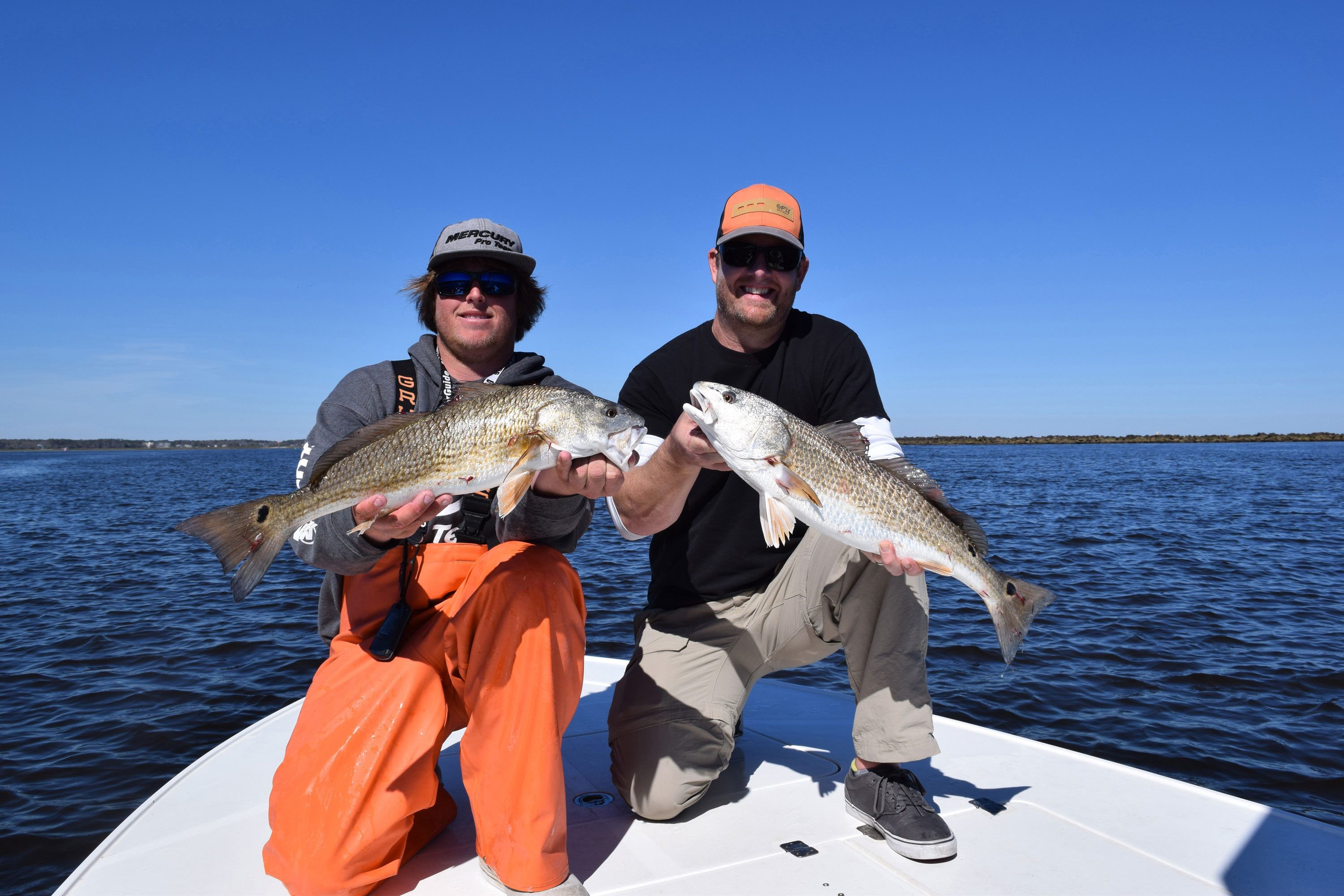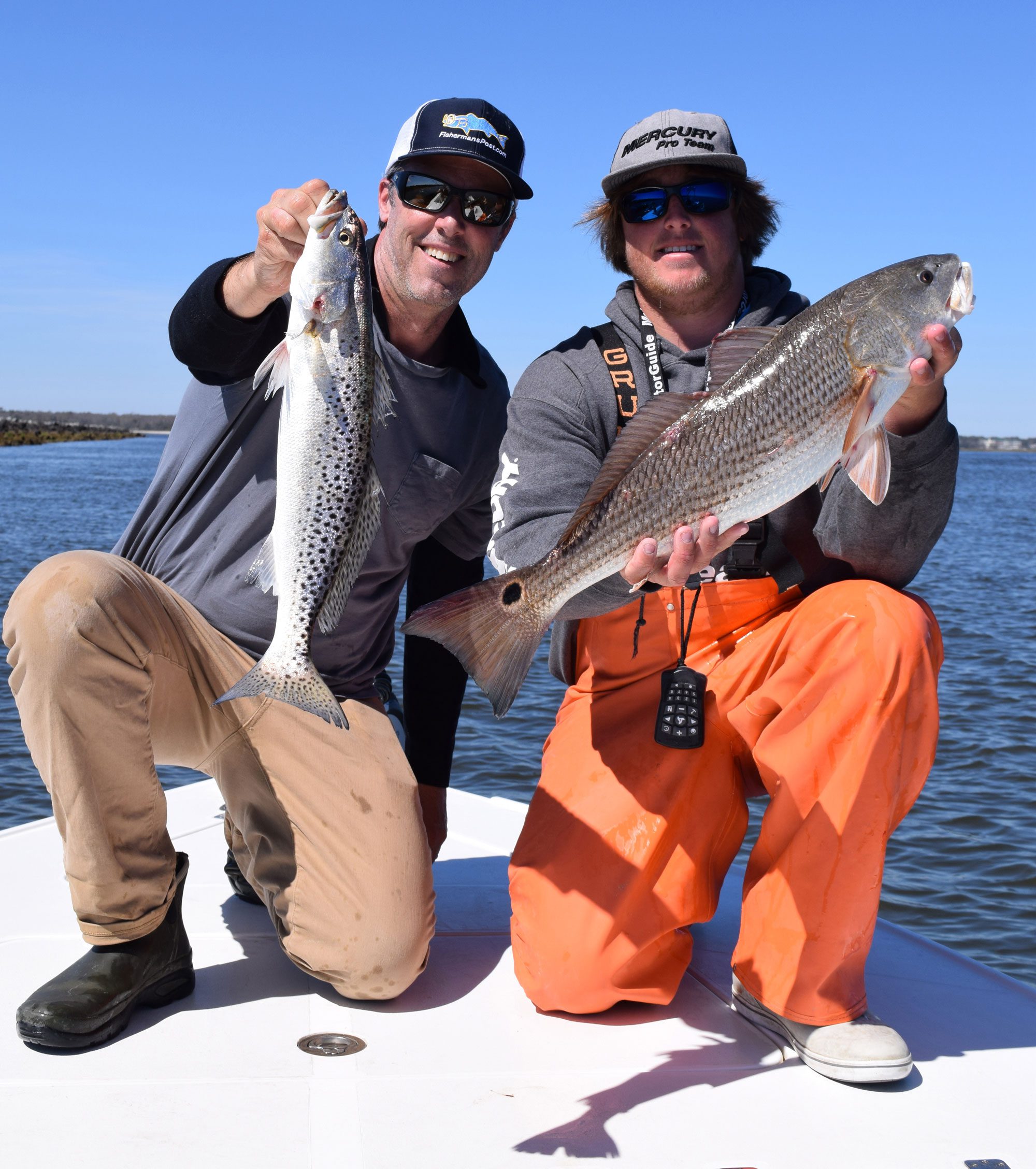Tidelines – April 11, 2019
Capt. Tripp Hooks, of Capt. Hook Outdoors in the Ocean Isle area, had me at “a recently-improved trout bite on the Little River jetties.” Then when I found out that he had just put clients on two citation specks, and that other boats in the area were also finally seeing some of the bigger trout that they had been expecting all winter, I booked my Sunday afternoon, meeting him at the Ocean Isle public boat ramp at the base of the bridge.
Tripp’s 23’ Famous Craft was tied up and armed with a baitwell full of live shrimp, so Tom Favor (brother-in-law) and I stashed some food and drink in one of his coolers and hopped aboard for one of the first truly beautiful spring days of the season.
On the day before with the citation specks (one 5+ and the other 6+ pounds), the bite had happened in the early afternoon, so we were in no hurry at 12:00 noon as Tripp headed south down the ICW towards the jetties.
The water, Tripp mentioned, both inside and out at the jetties, was a different color on our day than just the day before. Ours was clearer, and while I was thinking clearer water would be a positive, Tripp’s mentality was different.
“I’m used to fishing non-clear water. I prefer non-clear,” he explained, seeing the section of rocks he wanted to target first and noting that the tide had just barely started to fall, “because with clear water the fish can see your tackle better.”

Capt. Tripp Hooks, of Capt. Hook Outdoors out of Ocean Isle, and Tom Favor with two of the red drum they hooked floating shrimp on a bobber rig. They were fishing the Little River jetties on the outgoing tide.
Tom and I were each handed a light tackle rod with a slip bobber rig. Tripp adjusted each of our rubber stops and continued, “The trout are usually going to be off the side of the rocks. It’s just about finding them. Sometimes you will try setting the stop at 4 feet and catch them, but 9 times out of 10, the 8-10 foot range does so much better.”
Most of the water we were drifting was about 15’ deep, so an 8-10 foot set had our live shrimp near the bottom but up away from dragging or (most of the time) getting snagged. Tripp catches all of his live shrimp from May through October, but not in late March when we were aboard. Our shrimp, we found out, had made the trip up from Murrells Inlet, and it didn’t take long for the shrimp to work.
My bobber went down almost immediately after the cast, but the pull didn’t feel like the classic head-shaking of our target species. The fight was a little more erratic, and Tripp was quick to predict that I had found one of the many sheepshead that populate the rocks.
My sheepshead, even though small, was fun to fight on light tackle, but too small to want to put in the cooler, so we released and I put out another shrimp. This drift lasted a little longer, but still ended with the same result—my bobber quickly disappeared under the surface, and this time I recognized that familiar head shake (and drag pull) of not just a speckled trout, but a “nice” speckled trout.
“I use a slip cork, rubber stop first, and then a bead to keep your cork from going through the rubber stop,” described Tripp after I had brought my trout into his waiting landing net. “Then I use about a 6-7 inch slip cork with a 3/8 oz. egg weight, go to a swivel, and then I usually use 12-14 inches of fluorocarbon below that, a split shot about half way down and tied to a #6 treble.”
“The split shot,” he continued, “goes about half way down the fluoro. It keeps the shrimp down. If you don’t put the split shot on there, the shrimp will just come straight to the top.”
While I was having success finding quality trout, Tom was doing better with the sheepshead. Most of our sheepshead bites, we all noticed, came when we were drifting close to the rocks. The trout bites typically came further off.
Not every bite and bobber pull down equaled a fish, though. Sometimes there was no bend in the rod, just a pull down. Tripp always checked out our bait before casting back out for clues as to what we had encountered.
“With a trout bite, the shrimp doesn’t look messed with at all. It will be just be dead,” he noted. “With the sheepshead, especially the smaller sheepshead, they bite off part of the shrimp, so the shrimp doesn’t come back whole.”

Gary Hurley with a 3 lb. trout and Capt. Tripp Hooks, of Capt. Hook Outdoors out of Ocean Isle, with an over-slot red drum. They were floating shrimp on the outgoing tide on the inside of the Little River jetties.
Our drifts continued, and while we hooked several trout and sheepshead, the bite did slow down and no longer seemed to promise that a citation speck was in our future.
Tripp asked if we wanted to try for some red drum. Of course we did, so he moved to drift a different part of the jetty, a place where some underwater rocks come further out, almost like they had spilled when building the jetty.
Tripp told us the red drum like that shallower spot, and it was maybe our third drift that proved his theory correct. Tom was the first to come tight to a red drum. His fish, which we measured later to be 29”, tried to use its size and the outgoing tide to its advantage, but patience and steady pressure eventually prevailed.
Capt. Tripp Hooks, of Capt. Hooks Outdoors out of the Ocean Isle area, can put his clients on red drum thought out the year. As he says, “Red drum are always an option.” He also loves to target the fall, winter, and spring trout bite, as well as the spring cobia and summer and fall flounder.
Capt. Hook Outdoors also has the “Black Pearl,” a 30’ Hydrasport, in its arsenal, in case you prefer heading offshore of the jetties.
If you’d like to have the pleasure of watching your bobber going under and then trying to guess whether you’re fast to a trout, red drum, or sheepshead, then give Tripp a call at (910) 540-7332, or visit him online at www.capthookoutdoors.com.
My suggestion? Book Tripp for anything he has available. The young captain is as fishy as anyone, thanks in large part to the tutelage of his father David who had him on the water since birth, fishing since age 3, mating (for his father) on offshore trips by age 9, and then guiding solo by age 18.
My other suggestion? Ask Tom, my brother-in-law, if you should crank down on the drag after hooking a red drum, or if you should just assume that Tripp, a professional angler and captain, has handed you a reel with the drag set just where it ought to be.
